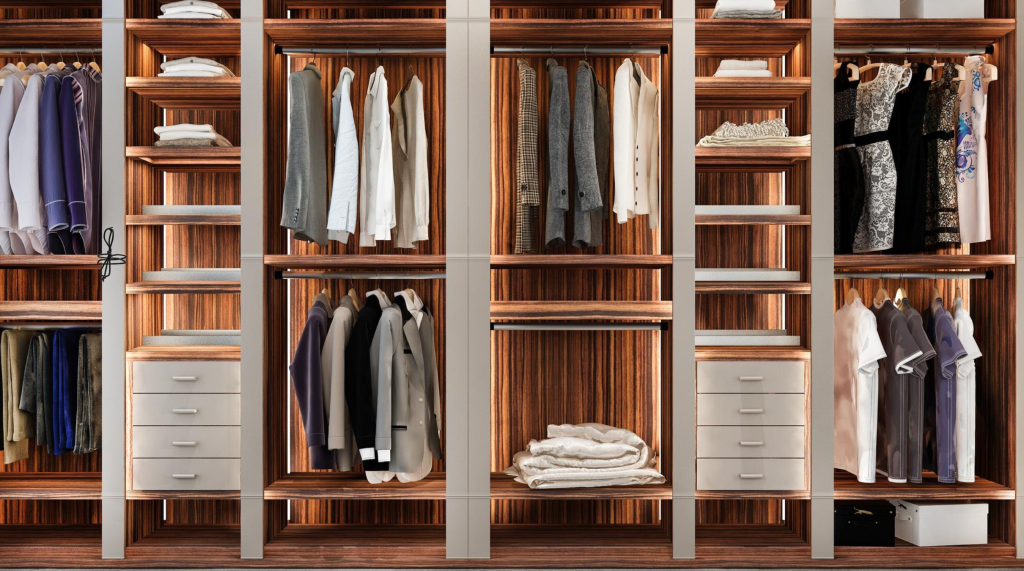Closets can either be a space of stress or serenity. When you open yours in the morning, does it inspire confidence—or chaos? Professional designers know that a well-organized closet isn’t just about storage; it’s about creating a system that supports your lifestyle, sparks joy, and reflects your personal style. The best part? You don’t need a walk-in closet or a massive wardrobe to achieve it.
Whether you live in a compact apartment or a spacious home, you can transform your closet into a beautifully curated space. Here’s how to organize your closet like a designer—with smart tips, stylish hacks, and functional ideas that work for every wardrobe.

👗 Step 1: Start With a Clean Slate
Designers always begin with a blank canvas—and so should you.
Take everything out of your closet. Yes, everything. This helps you see exactly what you own and gives you a chance to deep clean the space before restocking it with intention.
Ask Yourself:
- Do I wear this?
- Does it still fit and suit my lifestyle?
- Would I buy this again?
If the answer is “no” to any of these, it’s time to let it go.
Pro Tip: Separate clothes into categories: keep, donate, sell, or recycle. Apps like ThredUP or Poshmark can help you resell quality items.
🎨 Step 2: Define Your Closet Zones
Just like a designer outlines room zones for functionality, you should break your closet into specific areas.
Key zones might include:
- Everyday items: Things you wear regularly
- Occasion wear: Party dresses, blazers, or seasonal items
- Shoes and accessories: Make them visible and accessible
- Storage: Boxes or bins for off-season or sentimental pieces
Designers often use vertical space and unexpected areas (like the back of a door) to maximize every inch.
🧼 Step 3: Invest in Matching Hangers
Uniform hangers do more than just look good—they create order. Designers typically recommend:
- Slim, velvet hangers: These prevent slipping and save space.
- Wooden hangers: Ideal for structured jackets or coats.
- Clip hangers: Great for skirts and pants.
Mixing and matching may seem harmless, but consistent hangers instantly elevate the look and flow of your closet.
🎯 Step 4: Sort By Category, Then By Color
There’s a reason you’ll find retail stores arranged by category and color—it’s visually calming and efficient.
Try this order:
- Category: Dresses, shirts, pants, outerwear
- Color: Light to dark, left to right
Bonus tip: Arrange by length, with shorter items on one side and longer pieces on the other. This opens up floor space for storage bins or shoe racks.
🧺 Step 5: Use Designer-Like Storage Solutions
Function meets fashion in designer closets. Think of beautiful storage as both practical and visually pleasing.
Use:
- Clear acrylic boxes for jewelry or sunglasses
- Labelled baskets for scarves or belts
- Drawer dividers for socks, underwear, or bras
- Hanging organizers for handbags or folded knits
- Shelf risers to double vertical shelf space
Tip: Always measure your space before purchasing organizers to ensure a perfect fit.
👢 Step 6: Make Your Shoes Visible
Designers know shoes are more than accessories—they’re outfit anchors. Keep them easy to access and pleasing to the eye.
Smart storage options:
- Clear shoe boxes so you can see each pair
- Cubbies or stackable shelves to maximize space
- Over-the-door shoe racks for tight spaces
- Boot shapers to preserve shape and avoid creases
Store shoes heel-to-toe to save space and make it easier to spot pairs.
👜 Step 7: Display Accessories Like Art
Think of your accessories—hats, jewelry, belts—as part of the design. Use walls or open shelving to showcase them.
Display ideas:
- Hooks for hats or necklaces
- Corkboards with pushpins for earrings
- Tiered trays for bracelets or watches
- Small bins or drawer inserts for scarves and belts
Designers often rotate seasonal accessories for both style and practicality.
🔄 Step 8: Rotate Seasonally
Like fashion stylists do for photo shoots, rotate your closet every season.
Every 3–6 months:
- Store out-of-season items in bins or under-bed containers
- Refresh the front and center with weather-appropriate clothing
- Re-evaluate anything you haven’t worn in the last 6 months
This keeps your closet current and helps avoid clutter creep.
🧘♀️ Step 9: Maintain with Micro-Habits
Even the most beautifully designed space can fall into disarray without maintenance.
Daily habits:
- Put items back where they belong
- Fold and hang clothes right away
- Do a quick 5-minute tidy-up before bed
Monthly habits:
- Reassess items that haven’t been worn
- Re-fold and re-stack piles that have shifted
- Check for dust, moths, or musty odors
Staying consistent makes your closet feel designer-fresh all year round.
🌟 Step 10: Add a Personal Touch
Designers always bring in something that reflects personality. Your closet should feel like you.
Add:
- A stylish mirror
- A small rug for warmth and comfort
- Scented sachets or essential oil diffusers
- Framed photos, quotes, or fashion sketches
- LED lighting to highlight your wardrobe
Even the smallest personal touches can make a space more inviting and enjoyable.
🧠 Final Thoughts: Your Closet, Your Sanctuary
You don’t need to hire a professional to organize your closet like a designer. By using smart strategies—like sorting by color, choosing beautiful storage solutions, and maintaining regular decluttering—you can create a space that feels luxurious and functional.
An organized closet reduces stress, speeds up your morning routine, and lets your personal style truly shine. So, why wait? Take the first step, and transform your closet into a curated sanctuary you’ll love every single day.
📚 References
- National Association of Productivity and Organizing Professionals (NAPO). https://www.napo.net
- The Spruce – Best Closet Hangers of 2023. https://www.thespruce.com/best-clothes-hangers-4173936
- Real Simple – How to Organize Your Closet Like a Pro. https://www.realsimple.com






